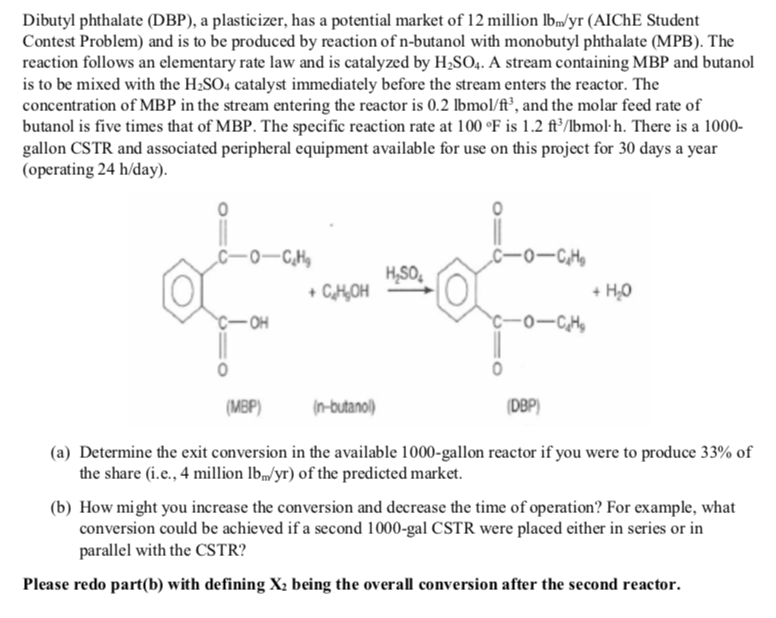Dibutyl phthalate (DBP), a plasticizer, has a potential market of 12 million lbm/yr (AICHE Student Contest Problem) and is to be produced by reaction of n-butanol with monobutyl phthalate (MPB). The reaction follows an elementary rate law and is catalyzed by H₂SO4. A stream containing MBP and butanol is to be mixed with the H₂SO4 catalyst immediately before the stream enters the reactor. The concentration of MBP in the stream entering the reactor is 0.2 lbmol/ft³, and the molar feed rate of butanol is five times that of MBP. The specific reaction rate at 100 °F is 1.2 ft³/lbmol-h. There is a 1000- gallon CSTR and associated peripheral equipment available for use on this project for 30 days a year (operating 24 h/day). -0-C₂H₂ C-OH + C₂H₂OH H₂SO₂ (n-butanol) C-0-C₂H₂ C-01C₂H₂ + H₂O (MBP) (DBP) (a) Determine the exit conversion in the available 1000-gallon reactor if you were to produce 33% of the share (i.e., 4 million lbm/yr) of the predicted market. (b) How might you increase the conversion and decrease the time of operation? For example, what conversion could be achieved if a second 1000-gal CSTR were placed either in series or in parallel with the CSTR?
Dibutyl phthalate (DBP), a plasticizer, has a potential market of 12 million lbm/yr (AICHE Student Contest Problem) and is to be produced by reaction of n-butanol with monobutyl phthalate (MPB). The reaction follows an elementary rate law and is catalyzed by H₂SO4. A stream containing MBP and butanol is to be mixed with the H₂SO4 catalyst immediately before the stream enters the reactor. The concentration of MBP in the stream entering the reactor is 0.2 lbmol/ft³, and the molar feed rate of butanol is five times that of MBP. The specific reaction rate at 100 °F is 1.2 ft³/lbmol-h. There is a 1000- gallon CSTR and associated peripheral equipment available for use on this project for 30 days a year (operating 24 h/day). -0-C₂H₂ C-OH + C₂H₂OH H₂SO₂ (n-butanol) C-0-C₂H₂ C-01C₂H₂ + H₂O (MBP) (DBP) (a) Determine the exit conversion in the available 1000-gallon reactor if you were to produce 33% of the share (i.e., 4 million lbm/yr) of the predicted market. (b) How might you increase the conversion and decrease the time of operation? For example, what conversion could be achieved if a second 1000-gal CSTR were placed either in series or in parallel with the CSTR?
Introduction to Chemical Engineering Thermodynamics
8th Edition
ISBN:9781259696527
Author:J.M. Smith Termodinamica en ingenieria quimica, Hendrick C Van Ness, Michael Abbott, Mark Swihart
Publisher:J.M. Smith Termodinamica en ingenieria quimica, Hendrick C Van Ness, Michael Abbott, Mark Swihart
Chapter1: Introduction
Section: Chapter Questions
Problem 1.1P
Related questions
Question

Transcribed Image Text:Dibutyl phthalate (DBP), a plasticizer, has a potential market of 12 million lbm/yr (AICHE Student
Contest Problem) and is to be produced by reaction of n-butanol with monobutyl phthalate (MPB). The
reaction follows an elementary rate law and is catalyzed by H₂SO4. A stream containing MBP and butanol
is to be mixed with the H₂SO4 catalyst immediately before the stream enters the reactor. The
concentration of MBP in the stream entering the reactor is 0.2 lbmol/ft³, and the molar feed rate of
butanol is five times that of MBP. The specific reaction rate at 100 °F is 1.2 ft³/lbmol-h. There is a 1000-
gallon CSTR and associated peripheral equipment available for use on this project for 30 days a year
(operating 24 h/day).
C-0-C₂H₂
-OH
+ C₂H₂OH
H₂SO₂
(n-butanol)
C-01C₂H₂
64²3-0-5
(MBP)
(a) Determine the exit conversion in the available 1000-gallon reactor if you were to produce 33% of
the share (i.e., 4 million lb/yr) of the predicted market.
(DBP)
+ H₂O
(b) How might you increase the conversion and decrease the time of operation? For example, what
conversion could be achieved if a second 1000-gal CSTR were placed either in series or in
parallel with the CSTR?
Please redo part(b) with defining X₂ being the overall conversion after the second reactor.
Expert Solution
This question has been solved!
Explore an expertly crafted, step-by-step solution for a thorough understanding of key concepts.
This is a popular solution!
Trending now
This is a popular solution!
Step by step
Solved in 3 steps with 2 images

Recommended textbooks for you

Introduction to Chemical Engineering Thermodynami…
Chemical Engineering
ISBN:
9781259696527
Author:
J.M. Smith Termodinamica en ingenieria quimica, Hendrick C Van Ness, Michael Abbott, Mark Swihart
Publisher:
McGraw-Hill Education

Elementary Principles of Chemical Processes, Bind…
Chemical Engineering
ISBN:
9781118431221
Author:
Richard M. Felder, Ronald W. Rousseau, Lisa G. Bullard
Publisher:
WILEY

Elements of Chemical Reaction Engineering (5th Ed…
Chemical Engineering
ISBN:
9780133887518
Author:
H. Scott Fogler
Publisher:
Prentice Hall

Introduction to Chemical Engineering Thermodynami…
Chemical Engineering
ISBN:
9781259696527
Author:
J.M. Smith Termodinamica en ingenieria quimica, Hendrick C Van Ness, Michael Abbott, Mark Swihart
Publisher:
McGraw-Hill Education

Elementary Principles of Chemical Processes, Bind…
Chemical Engineering
ISBN:
9781118431221
Author:
Richard M. Felder, Ronald W. Rousseau, Lisa G. Bullard
Publisher:
WILEY

Elements of Chemical Reaction Engineering (5th Ed…
Chemical Engineering
ISBN:
9780133887518
Author:
H. Scott Fogler
Publisher:
Prentice Hall


Industrial Plastics: Theory and Applications
Chemical Engineering
ISBN:
9781285061238
Author:
Lokensgard, Erik
Publisher:
Delmar Cengage Learning

Unit Operations of Chemical Engineering
Chemical Engineering
ISBN:
9780072848236
Author:
Warren McCabe, Julian C. Smith, Peter Harriott
Publisher:
McGraw-Hill Companies, The